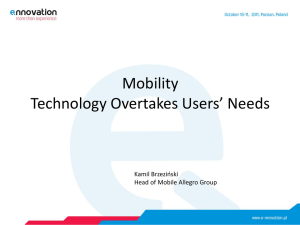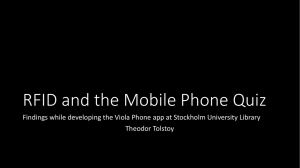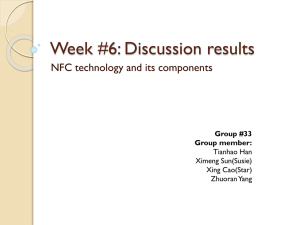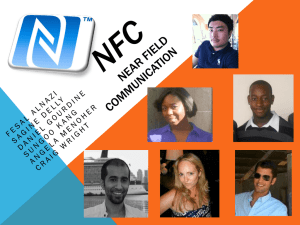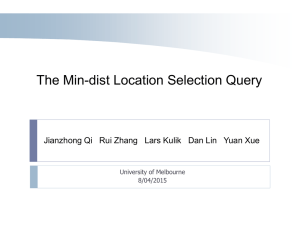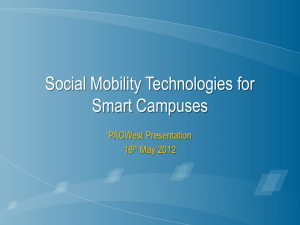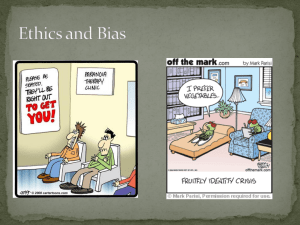Slides - Sigcomm
advertisement
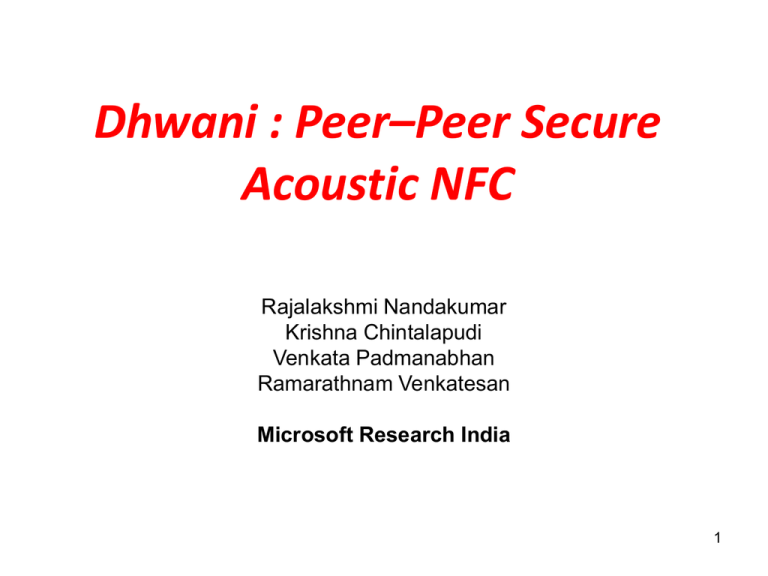
Dhwani : Peer–Peer Secure
Acoustic NFC
Rajalakshmi Nandakumar
Krishna Chintalapudi
Venkata Padmanabhan
Ramarathnam Venkatesan
Microsoft Research India
1
Near Field Communication (NFC)
•
Communication between
physically proximate devices.
•
Key Advantage: No network
configuration effort.
•
Association by proximity: devices
are connected to each other by
virtue of proximity
•
Used in contactless payments,
short data transfer, ticketing,
healthcare etc.
2
NFC - Limitations
•
Low levels of penetration of
NFC hardware today
– Works on the principle of
magnetic induction-special
hardware
– 12% in U.S., as of 2012
Can we enable
– penetration is expected
to be NFC-like
secure
under 50% globally by 2017
•
communication in
today’s devices ?
NFC standard does not define
security at the physical layer
– Assumes security is inherent
due to low range
– Snooping NFC transactions
has been demonstrated
(NISK 2009)
3
Yes. We can !
Dhwani - acoustic NFC system
• Uses phone’s speaker and
microphone.
• Software only – can be a
downloadable app.
• Currently supports upto 2.4 Kbps
data rate over 1 KHz bandwidth.
JamSecure – secure communication
• Information-theoretic approach to security.
• Security at physical layer by jamming
and self-interference cancellation at the
receiver.
4
Today’s Talk
• Dhwani : Acoustic NFC system
• Challenges in acoustic communication
• Dhwani – system design
• JamSecure : Secure NFC technique
• JamSecure - Idea
• Scope and Limitations
• Dhwani : Performance
• Performance of JamSecure
and communication system.
5
Acoustic Communication
RF Communication
Message
0001101..
Modulation
Decode
Sender
antenna
Receiver
antenna
Acoustic Communication
Speaker
Message
0001101..
Modulation
mic
Decode
6
Acoustic Communication Challenges
RF Communication
Acoustic Communication
1) Antenna frequency
response is flat
1) Speaker-mic frequency
selectivity
RF
channel
Sender antenna
Acoustic
Channel
Receiver antenna
2) Multipath (in µs)
3) Channel is defined –
interference is limited
Speaker
microphone
2) Echo (in ms)
3) Channel not defined –
ambient noise interference
7
Challenge 1 : Frequency selectivity
•
•
•
Imperfect electromechanical
conversion
Frequency response is not
uniform
Significant degradation above 12
KHz – significant data loss in that
band
8
Challenge 2 : Ringing and rise time
•
5ms long sine wave was
transmitted and received by a
nearby device.
Received signal
15 ms ringing
time
Causes ISI
Time (ms)
2 ms rise
time
9
Challenge 3 : Ambient noise
•
•
•
Ambient noise measured in
various locations
Significant till 6KHz in noisy malls
Can cause interference
Frequency spectrum of Ambient noise
10
Dhwani - Design
•
Software defined acoustic OFDM radio
– Ideal for frequency selective
channels {challenge 1}
• Carrier-less design
• 128 sub-carriers each 171Hz
• 4ms cyclic prefix {challenge 2}
• operating bandwidth 1 KHz (6-7KHz)
• high pass filter at the receiver {challenge 3}
•8 PSK in each subcarrier gives 2.4 Kbps
data rate.
….
0 1
6
7
10
Frequency (KHz)
22
Today’s Talk
• Dhwani : Acoustic NFC system
• Challenges in acoustic communication
• Dhwani – system design
• JamSecure : Secure NFC technique
• JamSecure - Idea
• Scope and Limitations
• Dhwani : Performance
• Performance of JamSecure
and communication system.
13
JamSecure - Idea
How much jamming is needed?
Transmitter
Receiver
A
BB
PA
5dB
no cancellation cancellation
PB
SIC gain = IC db
SNRB = PA-PB+IC db
E
Eavesdropper
SNRE = PAE – PBE db
SNRE ~= PA – PB db
• SNR at the eavesdropper is to the left of the
curve and SNR at the receiver is to the right of the
curve.
14
Key Challenge – Self Interference
cancellation
s(t) != r(t)
Channel estimation based SIC
s(t)
•Estimate the frequency dependant channel
gain by sending a known sequence
•The frequency resolution depends on the
reverberation in the channel
r(t)
Since reverberation is high (>15ms),
these techniques does not give high SIC
Hence estimate the
received signal r(t)
15
Key Observation
received signal r(t) ~= signal sent s(t)
•Speaker Microphone characteristics (static)
•Synchronization error (dynamic)
•Multipath (dynamic)
• Frequency response mostly
remains constant
Frequency selectivity is mostly
due to static speaker –
microphone characteristics
It can be pre-computed and
saved
16
JamSecure
Training Phase:
• generates a library of n PN sequences
PNixmit I = 1..N
• Transmits each of PN sequence and records the received signal.
PNirecv I = 1..N
PNxmit
PNrecv
PNixmit
PNirecv
17
JamSecure
Actual Jamming:
•If one jamming sequence is chosen randomly, eavesdropper can learn the
library over time.
K – Mixing factor
PNxmit
1
2
.
.
.
JamPNjxmit
k
r(t)
Due to linearity
PNrecv
1
2
.
.
.
k
JamPNjrecv
SIC
Key Advantage:
• Eliminates effects due to speaker – mic.
•Computationally intractable to learn PN
sequences for eavesdropper .
Compensating for dynamic
errors
•
Synchronization errors:
– Receiver maintains time-shifted versions of all signals.
– compares the received PN signal with all the time shifted versions at
different sample offsets
– Identifies the preamble start and sampling offset
•
Multipath errors:
– Estimates the channel using first few samples by fourier transform.
– Applies the corrections for each frequency component.
19
Limitations of JamSecure
The transmitter and the intended
receiver are trusted devices.
Eavesdropper
DoS attacks:
Happens when the eavesdropper
also starts jamming.
But does not leak the private data.
Directional antenna attacks:
Eavesdropper focuses only on the
transmitter
Hard in practice as it has to focus
into < 10cm.
Transmitter Transmission Receiver
Jamming
20
10cm
Today’s Talk
• Dhwani : Acoustic NFC system
• Challenges in acoustic communication
• Dhwani – system design
• JamSecure : Secure NFC technique
• JamSecure - Idea
• Scope and Limitations
• Dhwani : Performance
• Performance of JamSecure
and communication system.
21
Dhwani – Communication range
Packet success rates at different
transmission ranges
• Dhwani enables NFC
like communication with
range < 10cm
• PSR is 100% for BPSK
and 90% for QPSK
22
Performance of SIC
Self interference cancellation
Locations:
L1 : small conference room
L2 : large conference room
L3 : open pantry
Li-Lj : training at Li and
testing at Lj
For training and testing at
same location (L1-L1),
SIC > 10db when k = 5
For training and testing at
different locations, SIC >
6db
23
Related Work
Acoustic communication
“Audio Networking – The forgotten wireless technology” (IEEE pervasive
computing 2005)
– Provides extensive review of short and long distance acoustic
communication
– Uses on-off keying
– 270 bps data rate
JamSecure
IMDShield – “They can hear your heartbeats : Non-invasive security for
implanted medical devices” (Sigcomm 2011)
– Security for IMD without modifying them.
– base station that continuously listens to IMD transmissions and
transmits a jamming signal to secure it from eavesdroppers.
– channel estimation based SIC
– Dhwani a) software only b) pre-computed library based SIC
24
Dhwani
•Enables NFC in today’s devices
•Software only solution
•Provides security at physical layer
Questions
25
